
by: Pamela Thomas, Bridges for Peace, United Kingdom
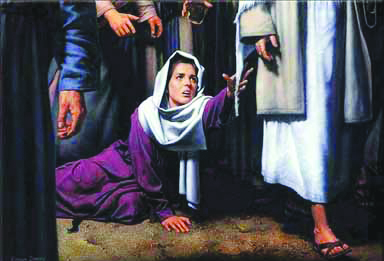 “Now a certain woman had a flow of blood for twelve years and had suffered many things from many physicians. She had spent all that she had and was no better, but rather grew worse. When she heard about Yeshua [Jesus], she came behind Him in the crowd and touched His garment; for she said, ‘If only I may touch His clothes I shall be made well.’ Immediately the fountain of her blood was dried up, and she felt in her body that she was healed of the affliction. And Yeshua, immediately knowing in Himself that power had gone out of Him, turned around in the crowd and said, ‘Who touched My clothes?’ But His disciples said to Him, ‘You see the multitude thronging You, and You say, “Who touched Me?”’ And He looked around to see her who had done this thing. But the woman, fearing and trembling, knowing what had happened to her, came and fell down before Him and told Him the whole truth. And He said to her, ‘Daughter, your faith has made you well. Go in peace, and be healed of your affliction’” (Mark 5:25–34).
“Now a certain woman had a flow of blood for twelve years and had suffered many things from many physicians. She had spent all that she had and was no better, but rather grew worse. When she heard about Yeshua [Jesus], she came behind Him in the crowd and touched His garment; for she said, ‘If only I may touch His clothes I shall be made well.’ Immediately the fountain of her blood was dried up, and she felt in her body that she was healed of the affliction. And Yeshua, immediately knowing in Himself that power had gone out of Him, turned around in the crowd and said, ‘Who touched My clothes?’ But His disciples said to Him, ‘You see the multitude thronging You, and You say, “Who touched Me?”’ And He looked around to see her who had done this thing. But the woman, fearing and trembling, knowing what had happened to her, came and fell down before Him and told Him the whole truth. And He said to her, ‘Daughter, your faith has made you well. Go in peace, and be healed of your affliction’” (Mark 5:25–34).
It would be impossible to record how many times this portion of Scripture has been read and accepted as being a wonderful example of faith in Yeshua (Jesus) and a demonstration of the authority of the Son of Man over every realm, over disease, nature, and tradition, but then, sadly, just laid aside until we are prompted by the Holy Spirit to recall the incident again. As with so many of the miracles performed by Yeshua, however, there is a wealth of teaching, revelation, wonder, and authority to be gleaned when we take the time to delve beneath the surface of what we are reading. In order to capture a greater understanding of this passage of Scripture, we would benefit from an understanding of the Hebrew background of this miracle.
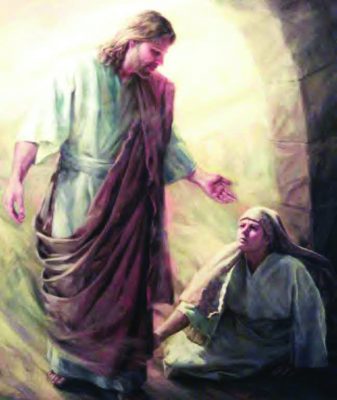 This miracle is recorded on three occasions in the Scriptures, as quoted above in Mark 5:25–34, in Matthew 9:20–22, and in Luke 8:43–48. In all three accounts, there is no record of the woman’s name, but the record in Mark tells us many things about her condition, healing, and confession before Yeshua. Her physical condition of constant hemorrhaging would have rendered her ceremonially unclean so that she would have been ostracized from her community: forbidden to attend services in the Temple or synagogue, having to keep her distance from everyone, and unable to mingle with people (Lev. 15:19–33). For 12 years, she had been separated, isolated, and in pain and distress from this constant flow of blood. She had no money left with which to seek any further medical help and her condition was worsening.
This miracle is recorded on three occasions in the Scriptures, as quoted above in Mark 5:25–34, in Matthew 9:20–22, and in Luke 8:43–48. In all three accounts, there is no record of the woman’s name, but the record in Mark tells us many things about her condition, healing, and confession before Yeshua. Her physical condition of constant hemorrhaging would have rendered her ceremonially unclean so that she would have been ostracized from her community: forbidden to attend services in the Temple or synagogue, having to keep her distance from everyone, and unable to mingle with people (Lev. 15:19–33). For 12 years, she had been separated, isolated, and in pain and distress from this constant flow of blood. She had no money left with which to seek any further medical help and her condition was worsening.
The Scriptures clearly mention that there was a crowd of people surrounding Yeshua as word of Yeshua’s acts of healing had spread over the Galilee region. To reach Yeshua, the woman would have had to push her way through the crowd. It would seem that she came with determination in her heart to receive healing from Yeshua and was convinced that if she could only touch the hem or border of His garment, she would be healed. It is possible that her condition would have made her not want to confront Yeshua in public. The woman also knew that in Judean society of the day, it was a major transgression for a man to talk to a woman other than his wife or children.
However, the actions of Yeshua of Nazareth towards women were revolutionary; He consistently treated women and men as equals. When she touched the hem of Yeshua’s garment, was it merely a point of contact, or was she aware that by touching the hem of Yeshua’s garment, she was actually touching the authority of God over her situation? What did the hem of Yeshua’s garment represent?
Harper’s Encyclopedia of Bible Life suggests Jewish men at the time of
Yeshua would have worn four items of clothing:
• Tunic, the chaluq—a long, close-fitting tunic made of linen or wool and worn next to the skin
• Cloak, the tallit—a square garment that bore tassels at the corners, usually made of one piece of the finest material, woven without seams
• Headgear—possibly a turban or a covering for the head, back of the neck, and shoulders
• Sandals
In Yeshua’s day, the tallit was worn over the tunic at all times when they were outside their home. It was a large rectangular cloth, which draped over the shoulder and fell to the ankles and served as protection against the elements. On each of its four corners, a knotted tassel (tzitzit) was attached in obedience to the biblical command in the book of Numbers.
In the Mark passage at the beginning of this chapter, he states that the woman wanted to touch Yeshua’s “clothes.” However, in Matthew and Luke’s accounts, they state she wanted to touch the “hem” of His garment. (See Matt. 9:20 and Luke 8:44.) “Hem” in English is a translation of the Greek word kraspedon. In Strong’s Concordance, word # 2899, kras-ped-on is of uncertain derivation: a margin, i.e., (specifically) a fringe or tassel.
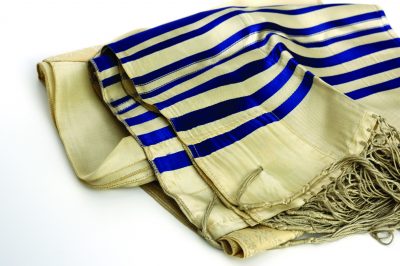 To understand the history and significance of the tallit, it is best understood in its biblical context. “Again the LORD spoke to Moses, saying, ‘Speak to the children of Israel: Tell them to make tassels on the corners of their garments throughout their generations, and to put a blue thread in the tassels of the corners. And you shall have the tassel, that you may look upon it and remember all the commandments of the Lord and do them, and that you may not follow the harlotry to which your own heart and your own eyes are inclined, and that you may remember and do all My commandments, and be holy for your God. I am the Lord your God, who brought you out of the land of Egypt, to be your God: I am the Lord your God’” (Num. 15:37–41). “You shall make tassels on the four corners of the clothing with which you cover yourself” (Deut. 22:12).
To understand the history and significance of the tallit, it is best understood in its biblical context. “Again the LORD spoke to Moses, saying, ‘Speak to the children of Israel: Tell them to make tassels on the corners of their garments throughout their generations, and to put a blue thread in the tassels of the corners. And you shall have the tassel, that you may look upon it and remember all the commandments of the Lord and do them, and that you may not follow the harlotry to which your own heart and your own eyes are inclined, and that you may remember and do all My commandments, and be holy for your God. I am the Lord your God, who brought you out of the land of Egypt, to be your God: I am the Lord your God’” (Num. 15:37–41). “You shall make tassels on the four corners of the clothing with which you cover yourself” (Deut. 22:12).
In both the above Scriptures, the Israelites were commanded to wear fringes (tassels or twisted coils) on the corners of their garments to remind them of the commandments of the Lord. The commandment was not to wear the tallit; it had no significant value other than a cloak in biblical times. The commandment was to wear the tassels, the tzitzit, on the four corners.
For the Jew, there is a numerical significance to most everything. This is especially true for the tallit. In Hebrew, each letter of the alphabet has a numerical value, so each word has a numerical value. For example, 26 is the numerical value of YHWH (the unpronounceable name of God often translated LORD), and 13 is the numerical value of echad (one). Therefore, “the Lord is one” can be spelled out numerically on each tzitzit with four sets of windings (7+8+11=YHWH,+13=echad), each separated by a double knot, for a total of 39 windings.
A second observation is the fact that all four tzitzit are a symbol of the 613 laws of Moses: 365 prohibitions (thou shall not) and 248 affirmations (thou shall). How is this so? The numerical value of the word tzitzit is 600. Add the eight strands and five knots each tassel is made of and you have 613. Also, each tassel has seven white strands, the number of perfection, surrounded by a blue strand depicting royalty or a reminder of God in heaven who watches over our every action.
Today, when we see a tallit, it is somewhat rare to see the blue strand mentioned in Numbers 15. The majority of modern talliot have eight white strands. Over time it would seem that this tradition was almost lost, but it is undergoing a revival today. In ancient times, the source of the only permanent blue dye was available from the glands of the hillazon snail (sometimes known by other names, e.g. Murex snail). It would require thousands of snails to collect a very small quantity of dye and, in comparison to monetary value, would probably cost tens of thousands of dollars today to create a pound weight of blue cloth. This is one of the reasons that the tzitzit with the techelet (blue dye) were removed from the tallit before it was used to wrap the head of the dead for burial and was often passed on from father to son as an heirloom and precious legacy.
Why was so much attention and detail given to the construction of these fringes?
Dr. Douglas A. Wheeler, in his article “The Law of the Fringe” in the Restore! magazine (vol. 3/32), suggests that the fringes were there not only to remind the Israelites to perform the commands, but also to remind them that life was not to be lived by their own understanding and their own intelligence. Life was to be lived dependent upon God and not independently of Him. The kind of life that God wanted the Israelites to live was not only one of obedience, but also one of trust and faith in Him, a life that is bound, wrapped, and tied up in the Lord.
What a wonderful lesson we learn just from observing the fringes of a garment! This is how we can live our lives—through faith, in cooperation with God, wrapping and binding our lives with the life of the Lord.
The proper use of the fringe was intended to keep a person’s life pure and so bring him into closer communion with God.
 There seemed to be no fixed maximum length for the tzitzit, but it appeared that there were some Pharisees at the time of Yeshua who wore very long tzitzit in order to appear more pious than they were. Matthew 23:5 records Yeshua’s words: “But all their works they do to be seen by men. They make their phylacteries broad and enlarge the borders of their garments.” In Yeshua’s days, the quality of your tassel apparently indicated your social rank. Wearing the tassels should have had the opposite effect. How sad that some Pharisees were so out of step with God’s instruction about wearing the tzitzit that it was necessary for Yeshua to comment on their behavior: “Therefore, whatever they tell you to observe, that observe and do, but do not do according to their works, for they say, and do not do” (Matt. 23:3).
There seemed to be no fixed maximum length for the tzitzit, but it appeared that there were some Pharisees at the time of Yeshua who wore very long tzitzit in order to appear more pious than they were. Matthew 23:5 records Yeshua’s words: “But all their works they do to be seen by men. They make their phylacteries broad and enlarge the borders of their garments.” In Yeshua’s days, the quality of your tassel apparently indicated your social rank. Wearing the tassels should have had the opposite effect. How sad that some Pharisees were so out of step with God’s instruction about wearing the tzitzit that it was necessary for Yeshua to comment on their behavior: “Therefore, whatever they tell you to observe, that observe and do, but do not do according to their works, for they say, and do not do” (Matt. 23:3).
Let us ensure that we do not fall into the same trap. Let the desire of our heart be to perform God’s commandments from our love of Him and from inward conviction and humility. God wanted the Pharisees (and us) to live in obedience and put their trust and faith in Him.
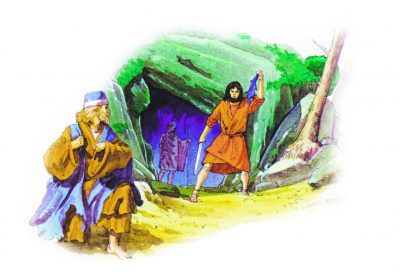 There are other instances in God’s Word where the tzitzit are recognized as representing authority. For example, we read in Ruth 3:9: “And he said, ‘Who are you?’ So she answered, ‘I am Ruth, your maidservant. Take your maidservant under your wing, for you are a close relative.’” The Hebrew word for “wing” is kanaph. It is most often translated as “wing” but is also translated as “skirt” or “corner.”
There are other instances in God’s Word where the tzitzit are recognized as representing authority. For example, we read in Ruth 3:9: “And he said, ‘Who are you?’ So she answered, ‘I am Ruth, your maidservant. Take your maidservant under your wing, for you are a close relative.’” The Hebrew word for “wing” is kanaph. It is most often translated as “wing” but is also translated as “skirt” or “corner.”
Ruth laid down at the feet of Boaz, and as he awakened, he was moved by her vulnerability. Boaz was an honorable man who recognized that she was placing herself under his authority. Ruth had the right to be covered by her spouse’s tallit, a symbolic expression of marriage. Boaz arranged immediately with her nearest kinsman for the right to buy the family property and marry Ruth.
In Psalm 91, we read that “He who dwells in the secret place of the Most High shall abide under the shadow of the Almighty…He shall cover you with His feathers, and under His wings you shall take refuge…” Once again, “wings” is translated from the Hebrew kanaph. What a wonderful place for us as believers to be—under God’s authority, a place of safety and intimacy.
1 Samuel 24:1–22 records the story of Saul’s pursuit of David at the caves of Ein Gedi. Saul had returned from following the Philistines and was told that David was in the Wilderness of Ein Gedi. Then Saul took 3,000 chosen men and went to seek David out. While Saul was in a cave, David and his men were also there, and David’s men said to him, “…This is the day of which the Lord said to you, ‘Behold, I will deliver your enemy into your hand, that you may do to him as it seems good to you…’” (vs.4). David secretly cut off a corner (kanaph) of Saul’s robe. The corners of Saul’s robe held the tzitziot and were one of the symbols of his authority.
Afterwards, David’s heart was troubled because he had cut Saul’s robe, illustrating that Saul would be humiliated. David said to his men, “The Lord forbid that I should do this thing to my master, the Lord’s anointed, to stretch out my hand against him, seeing he is the anointed of the Lord” (vs.6).
The Scriptures go on to tell us that David went out of the cave and called out to Saul saying “…My lord the king!…” (vs.8). David humbled himself before Saul and said to Saul, “…Why do you listen to the words of men who say, ‘Indeed David seeks your harm’? Look, this day your eyes have seen that the Lord delivered you today into my hand in the cave, and someone urged me to kill you. But my eye spared you, and I said, ‘I will not stretch out my hand against my lord, for he is the Lord’s anointed.’ Moreover, my father, see! Yes, see the corner of your robe in my hand! For in that I cut off the corner of your robe, and did not kill you, know and see that there is neither evil nor rebellion in my hand, and I have not sinned against you…” (vs.9–11). David’s act of giving back Saul’s authority brought reconciliation between the two men.
In Symbols of Judaism, Marc Alain Quanknin says “that observing a ritual requires knowing how to recognize the divine name in its many forms manifest in the reality surrounding us.” Today, from early childhood onwards, men usually wear a small tallit or (tallit katan) under their clothes. Sometimes the end of the tzitzit can be seen sticking out from under a man’s shirt or jacket. The tallit is kept for life and even beyond, with the custom of burying the dead in a tallit after the tzitzit have been removed.
According to the Code of Jewish Law, “Severe is the punishment of the one who neglects the performance of the Divine Command in putting on the tzitzit.” The whole purpose of the tzitzit is “that you may look upon it and remember all the commandments of the Lord and observe them…” (Num. 15:39). The Talmud remarks, “This ordinance is equal to all precepts, because seeing leads to remembering and remembering to performing” (Menahot 43b).
It is interesting to note that the design of Israel’s flag was inspired by the tallit with two stripes of blue and a Star of David in the middle. What a wonderful reminder for the nation of Israel to be under the authority and command of God.
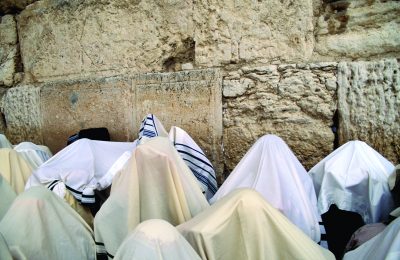 With the understanding of the significance of the tzitzit, we can now complete the story of the woman with the issue of blood. What was really happening here was more than just a woman making a decision to seek healing at the hands of the Lord. Although there was no promise to the woman concerning healing by touching the tzitzit, it is possible that she knew of the traditional interpretation of Malachi 4:2 associated with the Messiah’s tzitzit possessing healing powers: “But to you who fear My name the Sun of Righteousness shall arise with healing in His wings; and you shall go out and grow fat like stall-fed calves.” This would explain why she sought to touch the corner or hem (“wings”) of Yeshua’s tallit. Numbers 15:38 and Malachi 4:2 use the same word for corner, kanaph. With the Hebraic context intact, one wearing a tallit could be said to be dwelling “in the secret place of the Most High” and “under His wings” (Ps. 91:1–4).
With the understanding of the significance of the tzitzit, we can now complete the story of the woman with the issue of blood. What was really happening here was more than just a woman making a decision to seek healing at the hands of the Lord. Although there was no promise to the woman concerning healing by touching the tzitzit, it is possible that she knew of the traditional interpretation of Malachi 4:2 associated with the Messiah’s tzitzit possessing healing powers: “But to you who fear My name the Sun of Righteousness shall arise with healing in His wings; and you shall go out and grow fat like stall-fed calves.” This would explain why she sought to touch the corner or hem (“wings”) of Yeshua’s tallit. Numbers 15:38 and Malachi 4:2 use the same word for corner, kanaph. With the Hebraic context intact, one wearing a tallit could be said to be dwelling “in the secret place of the Most High” and “under His wings” (Ps. 91:1–4).
 The woman had heard that Yeshua was the Messiah. It seemed that was also the opinion of many as revealed by the crowds who sought His healing powers. It also explains why this woman was instantly healed. She was expressing her belief that Yeshua was the Son of Righteousness, the awaited Messiah.
The woman had heard that Yeshua was the Messiah. It seemed that was also the opinion of many as revealed by the crowds who sought His healing powers. It also explains why this woman was instantly healed. She was expressing her belief that Yeshua was the Son of Righteousness, the awaited Messiah.
When the woman reached out in faith, Yeshua not only restored the woman physically with healing, but also restored her socially by calling her “daughter.” He accepted her. He wasn’t angry. He blessed her with God’s peace and restored her self-esteem. Yeshua was saying to her that her faith in God had brought about her complete healing and restoration.
Understanding the purposes of these fringes can give us a beautiful insight into the depth of relationship that the Lord desires to have with His people. Yeshua is very much aware of the vulnerability of our faith, but He always wants us to be encouraged to put our fears aside and trust in Him. He would have us come to the place where we can reach out to Him for His promises and believe in Him.
This Teaching Letter is taken from our book, ISRAEL AND THE CHURCH: GOD’S ROAD MAP, an anthology written by Rebecca J. Brimmer and several Bridges for Peace leaders around the world. To order your copy, click here.
Lexicon and Strong’s Concordance Blue Letter Bible, 1996-2002. www.blueletterbible.org
Miller, Madeleine S., and J. Lane. Harper’s Encyclopedia of Bible Life. San Francisco:
Harper & Row, 1978.
Quaknin, Marc Alain. Symbols of Judaism. New York: Assouline Publishing, 2000.
Wheeler, Douglas A. “The Law of the Fringe,” Restore!
www.restoremagazine.org/volume_3/32_28.htm
Photo Credit: see photos for Photo Credits
All logos and trademarks in this site are property of their respective owner. All other materials are property of Bridges for Peace. Copyright © 2025.
Website Site Design by J-Town Internet Services Ltd. - Based in Jerusalem and Serving the World.